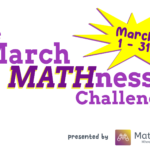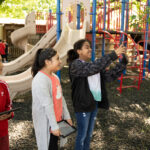
Now you can go on a Math Walk at the Dallas Museum of Art. We are excited to launch a new series of video guides exploring the connections between STEM (Science, Technology, Engineering, and Math) and art. You can go on a live, in-person math walk using these guides – an inspiring experience in which you can take in the beauty of five unique artworks housed in the museum galleries and view them in multiple ways, including through the lens of math! In this math walk, we focused on the theme of mathematical patterns and took a walk in four different galleries as well as the outdoor space of the museum. You can also visit the Museum virtually and view the video guides on your own, with your students, or with your family!
Additionally, these Dallas Museum of Art Math Walk stops are part of the MathFinder March Mathness Challenge – an interactive opportunity for students, families, and educators to get together and explore STEM, all while competing for a chance to win up to $100 a week! We’re having so much fun with the festivities that the March Mathness is officially extended to April 16, 2023 – for more information and testimonials, check out the challenge webpage here.
The DMA is a valued partner site in the MathFinder research project funded by the National Science Foundation and coordinated by SMU in partnership with talkSTEM. The museum has been a wonderful partner and collaborator with talkSTEM since we launched the walkSTEM initiative back in 2017. You can view the predecessor of one of the new math walk stops in the very first walkSTEM tour ever designed. That was this stop we made at the DMA in the walkSTEM @ Dallas Arts District tour. We refreshed the content of that video and all other math walk stops are brand new! Read more about the DMA in the Partner Spotlight section in the MathFinder Community’s March newsletter.
Come along on the MathFinder experience at the Dallas Museum of Art, as we investigate the principles behind color in mosaics, patterns and programming shapes in murals, self-similarity in patterns, and more! We are excited to share this new Math Walk that you can experience in person at your next visit to the Dallas Museum of Art or virtually thanks to the MathFinder project’s latest place-based video series.

This new video content can be viewed on the talkSTEM YouTube channel, the MathFinder open-access video library, or (very soon) on the free Otocast app, where you can also view satellite maps and locations of the tour stops. We encourage you take a trip to the DMA to enjoy the art featured in this tour up close, along with the rest of their wonderful collection! We hope that visitors of all ages from 8 and up will not only enjoy these works once they view them through a fresh perspective but that they will also enjoy posing their own math-and STEM-related questions as they view the museum’s fabulous galleries. We are grateful to all members of the DMA Education team and curatorial staff who participated with open minds and hearts in various ways including the selection of artworks, provision of background information for the artworks, script-writing, being on-video, and who will be actively using these resources to impact the youth who participate in the wide range of programs that the museum designs and offers. Further, a special thank you to Tamasha Govan, Director of Curriculum at St Philips School and Community Center (also a partner site in the MathFinder initiative), Valerie Gillespie (owner of Pencil on Paper Gallery in Dallas and Art Educator), and the amazing teen volunteers at the DMA (Francisco, Leo, Lucas, Raine, and Sanaa) for generously sharing their time so we could include their voices in these videos. Thanks also to Adriana Martinez-Mendoza (Manager of Teen Programs at the DMA) for her coordination of the teen volunteers so we could make it all work. Please do share your reactions and your own questions with us on our social platforms! We would love to hear from you.

This material is based upon work supported by the National Science Foundation under Grant DRL 2115393. Any opinions, findings, and conclusions or recommendations expressed in this material are of the(s) and do not necessarily reflect the views of the National Science Foundation. This tour is designed for upper elementary, middle and high school students.


